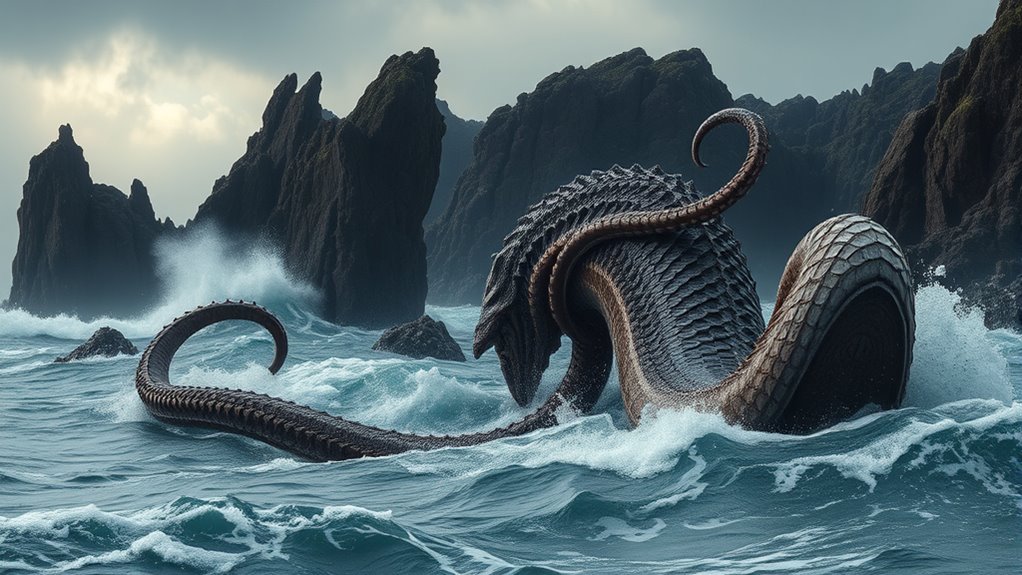In Norse sagas, the kraken symbolizes the immense, unpredictable power of the sea, representing both awe and terror. As a giant sea monster, it embodies the dangers Vikings faced during their voyages, often explained as natural threats like whirlpools or storms. It highlights the duality of the ocean—beautiful yet deadly—and reflects their fascination with the unknown. Keep exploring to uncover more about how this legendary creature shaped Viking stories and beliefs.
Key Takeaways
- The kraken originates from Norse sagas, symbolizing the ocean’s awe-inspiring and terrifying power.
- It serves as a mythic cautionary tale about the dangers and mysteries of maritime exploration.
- The creature embodies the duality of the sea: beautiful yet brutal, testing Viking courage.
- Depicted as a colossal beast capable of sinking ships and creating storms, reflecting nature’s dominance.
- The legend of the kraken shaped Viking sailors’ perceptions of ocean dangers and remains a powerful mythic symbol.

Have you ever wondered where the legendary kraken originated? This colossal sea creature has long captured imaginations, especially within Norse sagas that describe the fierce and mysterious power of the ocean. In these ancient stories, the kraken isn’t just a monstrous beast; it’s a symbol woven into the fabric of mythic symbolism, representing both the awe and fear that the sea inspires. For Vikings and other maritime explorers, the ocean was a vast unknown, filled with dangers lurking beneath the waves. The kraken embodied that danger—an enormous, tentacled creature capable of sinking ships and swallowing sailors whole. It’s no wonder that sailors of the Norse world saw the kraken as a divine force, a reminder of nature’s uncontrollable might, and a symbol of the perilous journey through uncharted waters.
In Norse sagas, the kraken often appears as an almost supernatural creature, a testament to the Vikings’ fascination with the sea’s secrets. Maritime exploration during their time was risky, and tales of sea monsters like the kraken served both as cautionary stories and as explanations for mysterious disappearances. These stories, passed down through generations, helped forge a collective understanding of the ocean’s unpredictable nature. The kraken’s mythic symbolism extends beyond just terrifying sailors; it also signifies the allure of discovery and the bravery required to venture into the unknown. As you read these sagas, you can sense how the creature embodies the duality of the sea—its beauty and its brutality. The Vikings’ encounters with the sea weren’t just physical journeys but spiritual ones, where confronting such monsters tested their courage and resilience.
The depiction of the kraken in Norse tales often emphasizes its size and power, illustrating why it became a symbol of ultimate maritime danger. It’s depicted as a creature so enormous that it could create whirlpools or cause storms, showcasing nature’s dominance over mankind. These stories weren’t just about monsters; they reflected the Vikings’ understanding of the ocean as a force beyond human control. The mythic symbolism embedded in the kraken’s stories helped explain the inexplicable and prepared sailors mentally for the dangers they faced. When you consider the rich tradition of maritime exploration in Norse culture, it’s clear that the kraken was more than a myth; it was a reflection of their respect, fear, and fascination with the sea’s mysterious depths. Modern research into maritime legends reveals how such myths served to communicate and cope with the dangers of the ocean. In the end, the legend of the kraken encapsulates the essence of Viking voyages—bold, perilous, and forever intertwined with the mythic power of the ocean.
Frequently Asked Questions
How Did the Myth of the Kraken Originate?
You might find that the myth of the kraken originated from marine folklore, where sailors reported sightings of enormous, mysterious sea creatures. These stories, passed down through generations, fueled curiosity and fear. Over time, these accounts evolved into the myth origins of the kraken, symbolizing the unknown dangers of deep-sea exploration. This legend grew as sailors shared tales of giant monsters lurking beneath the ocean’s surface, capturing imaginations worldwide.
Are There Any Real Creatures That Inspired the Kraken Legend?
You might be interested to know that marine biology suggests real creatures inspired the kraken legend, like giant squids and colossal octopuses. These sea monsters, with their enormous size and mysterious behaviors, fueled folklore origins and legends among sailors. Sightings and stories of these elusive deep-sea animals helped shape the myth, blending actual marine biology with mythic storytelling to create the legendary kraken.
How Has the Depiction of the Kraken Evolved Over Time?
You see that the depiction of the kraken has evolved through myth adaptation, shifting from a terrifying sea monster to a symbol of nature’s power and mystery. Over time, artists and storytellers have added details, making it larger and more formidable. This evolution reflects cultural symbolism, where the kraken embodies fears of the unknown and the unpredictable forces of the ocean, constantly adapting to new stories and interpretations.
What Role Did the Kraken Play in Norse Culture?
In Norse culture, the kraken played a significant role in marine folklore, symbolizing the mysterious and dangerous power of the sea. You’d see it as a representation of nature’s unpredictability and a cautionary figure for sailors venturing into unknown waters. The kraken’s presence reflected cultural symbolism, emphasizing respect for the sea’s might and the importance of survival skills in a maritime society.
Are There Modern Sightings or Evidence of Giant Sea Monsters?
You might have heard about modern sightings of marine cryptids, but there’s no concrete evidence confirming the existence of giant sea monsters like the kraken. Many enthusiasts report strange, massive creatures in deep oceans, fueling speculation and folklore. However, scientists generally consider these sightings unproven and often explain them as misidentifications of known marine animals or natural phenomena. So, while intriguing, evidence of such giant sea monsters remains elusive.
Conclusion
As you imagine the kraken lurking beneath the waves, it becomes more than just a monster—it’s a symbol of the unknown, of nature’s boundless power. It whispers that beneath our understanding lies mystery and awe, reminding you that some forces are beyond control. Embrace the fear and wonder, for in that darkness, you find the true essence of the Norse spirit—resilient, daring, and forever seeking the depths of the unknown.










